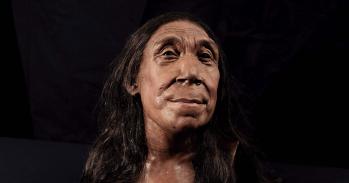Cambridge archaeologists are illuminating some of the oldest graphic art of the past, by applying some of the most advanced graphic technology of the present.
Cambridge archaeologists are illuminating some of the oldest graphic art of the past, by applying some of the most advanced graphic technology of the present.
Watching the sun arc and fall over one of these panels, and seeing the individual figures leap out then disappear was revelatory
Frederick Baker
We tend to think of archaeological investigation as getting down and dirty with the physical evidence of vanished people – skeletal remains, submerged foundations, the charred detritus of daily life. This is evidence with substance that can be analysed, dated, pieced together. But what do archaeologists do with sculptures that are made of air? In the case of the 150,000-plus engravings of the Valcamonica valley in the Italian Alps, the images have been carved out of the sandstone rock. They are a subtraction from it.
From about 4,000 BC up to medieval times, with activity concentrated in the 1st millennium BC, the peoples of the valley have hewn pictures out of the rocks with stones or tools. Dr Christopher Chippindale, rock art expert and Curator at the Museum of Archaeology and Anthropology, and Dr Frederick Baker, film-maker and Senior Research Associate at the McDonald Institute for Archaeological Research, use the local dialect term for these engravings: pitoti, or ‘little puppets’.
Baker describes the pitoti as “Giacometti meets landscape artist Richard Long, by way of Paul Klee.” Human figures – ‘orants’ – with arms raised as if in angular attitudes of worship, weapon-clad warriors sparring in pairs, priests and priestesses with halo-like headdresses, jiving dancers, grazing animals, wagons, wheels, houses and symbols form a communal autobiography of mankind.
Examining and analysing such ephemeral images in the absence of any formal knowledge of the circumstances that produced them, let alone interpreting the curious clustering of the pitoti on around 2,000 rock faces across a 70-km-long valley, has challenged archaeologists since the pitoti were discovered as an archaeological phenomenon over a century ago.
The response of Baker and Chippindale has been to approach the pitoti as pictures, with particular respect to what distinguishes them from paintings: their depth. Using digital imaging technologies such as laser-scanning, graphic animation and ambient cinematic techniques, they have formulated a new research methodology based on ‘visual excavation’ of these images as 3D entities.
This approach has thrown new light on the pitoti. “The first thing that struck me,” said Baker, “was that the pictures look like stills out of an animation. As a film-maker, my response was, ‘What happened next?’. When you take into account their depth this question becomes even more interesting, because the pitoti appear and vanish according to the angle of the sun. When it hits the rock obliquely, the image casts a shadow, and that is what makes the art visible to us. It is a natural 3D effect.”
Baker specialises in film projection. “So watching the sun arc and fall over one of these panels,” he recalled, “and seeing the individual figures leap out then disappear was revelatory. They form a landscape-based proto-cinema.”
The proto-cinematic metaphor is applicable to individual pitoti, some of which appear inexorably in transit to another action: the thrust of a spear; the parry of a shield; the flight of a startled deer. By laser-scanning then animating the engravings, Baker, Chippindale and Andreas Wappel (St Pölten University of Applied Science, Austria) found that our ancestors did record them in motion. “We animated an image of a bird,” explained Baker, “and not only got it to fly in an absolutely naturalistic sense, but found that concentric arcs inside its body were not plumage but follow the graphic logic of a bird’s beating wings.”
With rock faces as screens and the sun as a projector, the valley forms a natural amphitheatre. This begs the question of whether it also worked acoustically. Together with musicians playing instruments including a natural cow-horn, Baker and Chippindale tested the hypothesis that auditory performance was an aspect of a multi-sensory experience.
“We found that three key pitoti sites with distinctive iconography had extraordinary echoes, clearly audible to those standing in front of the art,” explained Baker. “You get a lot of echoes in mountains,” he continued, “but these sites had another common denominator: they are amongst the earliest rock art sites. Archaeologists have long wondered why they were chosen. Now we know that it is the echoes that matter.”
By using performance to explore a hypothesis about performance, the Cambridge team has opened up a new line of archaeo-acoustical research. It took just a day, but it was one that Chippindale will never forget. “This discovery was thrilling,” he said. “It was the most exciting day of my research life.”
3D realisation has thrown up a further indication that some of the pitoti are, literally, in suspended animation. A researcher from one of the partner institutions working with Baker and Chippindale, Marcel Karnapke from the Bauhaus University Weimar, converted a distinctive orant into a sculpture for an exhibition held in Milan and then in Cambridge’s Museum of Archaeology and Anthropology. “Far from being roughly symmetrical as had been assumed,” said Chippindale, “the figures stand, perfectly balanced, on their toes.”
“This is the power of the zero and the dot,” said Baker of these insights. “The digital level has enabled us to record more exactly, look more closely and, because the digital world is all about mutability and metamorphosis, to test hypotheses.”
Now, this research is being scaled up through an ambitious, pan-European project – 3D Pitoti – which began in March 2013 and is funded by the European Union. With Cambridge’s contribution led from the McDonald Institute, the project will use autonomous micro-aerial vehicles and develop portable robotic scanners to build on the lines of enquiry opened up by Chippindale and Baker, who will be joined by Cambridge archaeologists Professor Charly French and Dr Craig Alexander. The project will present the resulting resources and research in novel graphic, interactive and universally accessible digital forms.
The research will analyse the pitoti from multiple but inter-related perspectives, from the bird’s-eye view (their distribution and classification across the valley) to the human scale (their clustering within one site, and on individual rock panels). While ostensibly random, there are, in fact, significant patterns to the clustering. “These are agglomerations of images rather than compositions,” explained Chippindale. “We know that they were created over the course of centuries. But they are not placed in an unstructured way. There are affinities in terms of the type of image and its size. We can see, too, that artists typically avoided superimposing their images on their predecessors’ art.”
The research will zoom in to analyse whether the arrays of images have narrative meaning. It will examine individual pitoti to address the longstanding debate about the balance in prehistoric art between communal and individual expression. “The prevailing thinking is that the pitoti work on the communal level of, say, Arsenal fans spraying ‘AFC’ on the lampposts of Highbury. But perhaps we’re dealing with individuals like London street artist Banksy, leaving his message to posterity.”
This work is licensed under a Creative Commons Licence. If you use this content on your site please link back to this page.





